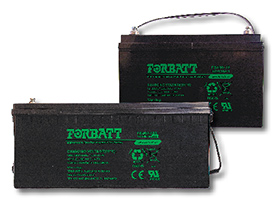

While many battery technologies have come to the forefront, lead-acid has remained the most well-known and cost-effective chemistry. Gel and AGM technologies have revolutionised this technology even further. With the new drive for alternative energy there has been a surge in demand, particularly for solar and power backup.
Unlike flooded batteries, these batteries are maintenance free. It is also easier to dispose of and recycle lead-acid batteries than other technologies. However, even within the lead-acid market there are brands that perform well and others that do not meet the grade. In the lead-acid battery world, you get what you pay for. Here are a few things to take into consideration when choosing a reliable, high-quality lead-acid battery.
Lead plate thickness
Deep-cycle lead-acid batteries for solar battery systems, forklifts, golf carts, emergency medical equipment and more are built for maximum capacity and a high cycle count. To achieve this, manufacturers of high-quality batteries, such as Forbatt, make their lead plates much thicker than those of low-quality manufacturers. The thickness of the plate means greater depth of discharge. Good quality deep-cycle batteries have thick plates for improved cycling ability.
When a battery starts to fail before its time, one of the factors is the thickness of the plates. Whilst it may be true that in the early stages of the battery’s life it will perform as well as the top brands, in the long run it will fail early. When it comes to cost vs. quality, in this instance quality means a longer lasting battery and this costs you much less in the long run.
When making your next purchase, try this simple tip to check for quality – holding all else equal, the heavier the battery is, the more lead it contains and will last longer than batteries with thinner plates.
Quality of the separator
The separator is one of the most critical components of the lead-acid battery. Too often, its role in determining performance and life is ignored. Although its primary function is to prevent electrical contact between plates of opposite polarity, it must also give free movement to sulphate ions through the electrolyte space but restrict the migration of antimony ions from the positive grid to the negative material when lead-antimony alloys are used.
High-quality batteries such as those manufactured by Forbatt use high-quality separators and tried and tested chemistries in their builds.
Portability
It’s an often-overlooked factor but a simple example of manufacturers who go the extra mile is to include handles on the battery casing for easy portability. Lead is heavy and manufacturers that are considerate of their customers have built handles into the heavier batteries. This small gesture makes a big difference when transporting or installing the batteries. Small gestures like this are what differentiate the cheap brands from the quality brands.
Choose quality over cost
Lead-acid has, for many years, been the predominant battery type for a host of applications, from gates and garage motors through to the storage choice for solar power. They are reliable, stable, efficient and cost-effective. However, today, there are many brands on the market and the purchase can be confusing with technical jargon and the trade-off between cost and quality.
Forbatt lead-acid batteries have been ranked the best lead-acid batteries on the market with a proven track record. These batteries have great capacity and are rated the best AGM and gel technologies, offering the best overall value.
The battery range is versatile – you can use it in a variety of applications that include solar applications, golf carts, gate and garage motors, motorcycles, access control electronics, emergency lighting, UPS power backup systems and much more.

© Technews Publishing (Pty) Ltd | All Rights Reserved